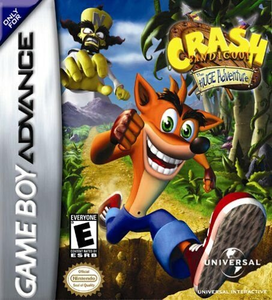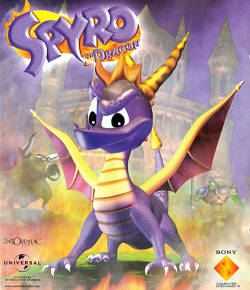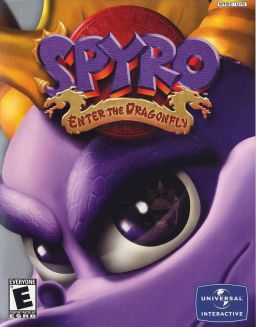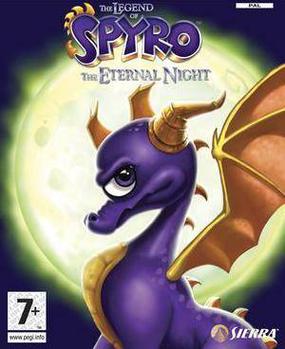
Spyro is a platform game series originally created by Insomniac Games as an exclusive for Sony's PlayStation console. The series features the adventures of the main protagonist of the same name, a dragon. Since the series' introduction in 1998, there have been numerous sequels and a reboot trilogy. The series was originally produced by Universal Interactive, later became known as Vivendi Games; the rights to the intellectual property were acquired by Activision after its merge with Vivendi in 2008.

Crash Bandicoot: The Huge Adventure is a 2002 platform game developed by Vicarious Visions and published by Universal Interactive for the Game Boy Advance. It is the seventh installment in the Crash Bandicoot video game series, the first Crash Bandicoot game not to be released on a PlayStation console, and the first Crash Bandicoot game to be released on a handheld console. The game's story centers on a plot to shrink the Earth by the main antagonist, Doctor Neo Cortex, through the use of a gigantic weapon named the "Planetary Minimizer". The protagonist of the story, Crash Bandicoot, must gather Crystals in order to power a device that will return the Earth to its proper size, defeating Doctor Cortex and his minions along the way.

Spyro the Dragon is a 1998 platform game developed by Insomniac Games and published by Sony Computer Entertainment for the PlayStation. The first game in the Spyro series, it stars the title character, a young purple dragon named Spyro, and his dragonfly friend, Sparx, who must journey across the Dragon Kingdom to defeat Gnasty Gnorc, who has overtaken the 5 dragon Homeworlds by trapping the other dragons in crystal and turning their hoard of gems into an army of minions. Spyro the Dragon is an open-ended 3D platformer, featuring large, sprawling levels in which the player must locate collectable items, among which are gemstones, crystallized dragons, and stolen dragon eggs. Spyro's abilities as a dragon include fire breath, a head-on charging attack, and a mid-air glide which he can use to scale large distances, all of which must be used strategically to find items and defeat enemies.

Breath of Fire is a role-playing video game developed by Capcom originally for the Super Nintendo Entertainment System. Initially released in Japan in April 1993, the game was later made available in North America in August 1994 by Square Soft, who handled the title's English localization and promotion. It is the first entry in the Breath of Fire series.

Spyro: A Hero's Tail is a 2004 platform game developed by Eurocom Entertainment Software and published by Vivendi Universal Games for the PlayStation 2, GameCube, and Xbox. It is the fifth console game in the original Spyro series and the ninth game in the series overall. Per usual, players act as the titular dragon collecting objects, platforming, flying, headbutting and breathing fire onto enemies to save the Dragon Realms. This time, he collects Dark Gems, which corrupt the land with maniacal creatures and deadly plants, planted by a banished Dragon Elder Red. Other characters, such as Sparx the Dragonfly, Hunter the Cheetah, Sgt. Byrd the Penguin, and newcomer Blink the Mole, are playable in mini-game stages.

Spyro: Season of Ice is a 2001 platform game developed by Digital Eclipse and published by Universal Interactive Studios for the Game Boy Advance. It acts as an alternate sequel to the first three games along with Spyro 2: Season of Flame and Spyro: Attack of the Rhynocs.

Spyro: Attack of the Rhynocs is a 2003 platform game developed by Digital Eclipse and published by Universal Interactive for the Game Boy Advance. It was the last Spyro game to release under the Universal Interactive label, as the label would be phased out shortly after the game's release. It was also the final Spyro game to be developed by Digital Eclipse, where for the next major handheld entries they would be replaced by Amaze Entertainment.

Spyro: Enter the Dragonfly is a 2002 platform game developed by Equinoxe Digital Entertainment and Check Six Studios and published by Universal Interactive for the PlayStation 2 and GameCube. It is the fourth main installment in the Spyro series. It is the first to be released on either console and the first to not be developed by the series creator, Insomniac Games.

Spyro 2: Ripto's Rage!, known as Spyro 2: Gateway to Glimmer in PAL regions, is a 1999 platform game developed by Insomniac Games and published by Sony Computer Entertainment for the PlayStation. It is the second game in the main Spyro series. A remake was released as part of the Spyro Reignited Trilogy in 2018.

Spyro: Year of the Dragon is a 2000 platform game developed by Insomniac Games and published by Sony Computer Entertainment for the PlayStation video game console. The third game in the Spyro series, Year of the Dragon follows the adventures of the titular purple dragon. After an evil sorceress steals magical dragon eggs from the land of the dragons, Spyro travels to the "Forgotten Realms" to retrieve them. Players travel across different worlds gathering gems and eggs, defeating enemies, and playing minigames. Year of the Dragon introduced new characters and minigames to the series, as well as offering improved graphics and music.

Crash Bandicoot: The Wrath of Cortex is a 2001 platform game developed by Traveller's Tales and published by Universal Interactive. It was first released for the PlayStation 2 and later ported to the Xbox, and GameCube, with Eurocom developing the GameCube version. It is the fourth main installment and the sixth overall in the Crash Bandicoot video game series, being the first of the series to not be released solely for a PlayStation console.

Crash Bandicoot 2: N-Tranced is a platform game developed by Vicarious Visions and published by Universal Interactive for the Game Boy Advance. The game was released in North America on January 7, 2003 and in Europe on March 14, 2003.

The Legend of Spyro: A New Beginning is a 2006 action-adventure video game in the Spyro series. It is the first installment in The Legend of Spyro trilogy. The game was released for the Game Boy Advance, Nintendo DS, GameCube, PlayStation 2, Xbox, and mobile.

The Legend of Spyro: The Eternal Night is a 2007 action-adventure video game in the Spyro series. It is the second installment in The Legend of Spyro trilogy and the sequel to The Legend of Spyro: A New Beginning (2006). It was released for the Game Boy Advance, Nintendo DS, PlayStation 2, Wii, and mobile.

The Legend of Spyro: Dawn of the Dragon is a 2008 action-adventure video game in the Spyro series. It is the third and final installment in The Legend of Spyro trilogy and the sequel to The Legend of Spyro: The Eternal Night (2007), marking the tenth anniversary of the game series. The game was released for the PlayStation 2, PlayStation 3, Xbox 360, Wii, and mobile.
The Legend of Spyro is a game trilogy that is part of the Spyro series. It acts as a reboot to the original series. The games use a combination of close-combat and platforming gameplay, though more oriented on combat than previous games in the Spyro series. The story revolves around Spyro, the protagonist, and his efforts to stop Malefor, the Dark Master, from escaping his ancient imprisonment to bring about an armageddon upon the world.

Crash Bandicoot Purple: Ripto's Rampage and Spyro Orange: The Cortex Conspiracy are two platform games published by Vivendi Universal Games. The games are developed by Vicarious Visions for the Game Boy Advance. They were released in North America on June 3, 2004, and in Europe on June 25, 2004 under the names Crash Bandicoot Fusion and Spyro Fusion.

Spyro is the titular main character and protagonist of the Spyro video game series, including The Legend of Spyro, and a guest character in the Skylanders series, first appearing in Spyro the Dragon in 1998.

Universal Interactive was an American video game publisher. The company was established on January 4, 1994, and led by Skip Paul and Robert Biniaz of MCA. It was best known for producing the Crash Bandicoot and Spyro platform game franchises.

Spyro Reignited Trilogy is a 2018 platform game compilation developed by Toys for Bob and published by Activision. It includes remakes of the first three games in the Spyro series: Spyro the Dragon (1998), Spyro 2: Ripto's Rage! (1999), and Spyro: Year of the Dragon (2000). Reignited was released for PlayStation 4 and Xbox One in November 2018, while Nintendo Switch and Windows versions released in September 2019. The collection received positive reviews from critics and has sold over 10 million units as of September 2023.




















